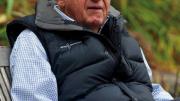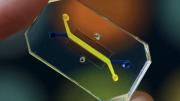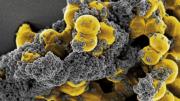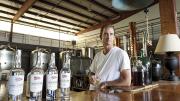With his $131-million gift in support of the Wyss Institute for Biologically Inspired Engineering, announced by the University on June 7, Hansjörg Wyss, M.B.A. ’65, has now made three gifts to the eponymous institute, totalling $381 million, which bring his total philanthropic support for Harvard to more than $400 million. The institute seeks to bridge the gap between academia and industry by drawing inspiration from nature’s design principles to solve some of the world’s most complex challenges in healthcare and the environment—and to commercialize those solutions to maximize their impact. It has had notable success during its first decade. Wyss’s decision to continue investing in the institute, just months after the Medical School unveiled a $200-million gift from the foundation of Len Blavatnik, M.B.A. ’89, to support basic research (see “Accelerating Medical Research,” January-February, page 18), indicates the University’s life-sciences prowess, and leading philanthropists’ willingness to underwrite it.
Wyss was CEO of Synthes, a biomedical research and device company that pioneered new techniques for healing traumatic bone breaks. In the middle of the last decade, Howard Stevenson, then a Harvard Business School professor and University vice provost, and a friend and classmate of Wyss, recalls that company’s focus this way: “How do you marry materials with biology?” As Harvard sought to organize its bioengineering research across the University and its affiliated hospitals, guided by a provostial committee co-chaired by the Medical School’s Folkman professor of vascular biology Don Ingber, an affiliate of Children’s Hospital Boston, and Pinkas Family professor of bioengineering David Mooney, a common interest arose. Wyss sought ways to put physicians, physicists, mathematicians, mechanical engineers—every pertinent discipline—together to work on various projects with high potential for life-changing applications. He agreed to make an initial gift of $125 million in 2009, with the University investing as well.
The institute that has resulted, led by Ingber in rented space in the Longwood Medical Area, now engages a rotating cast of about 375: 150 to 170 full-time staff, and 200-plus others, including 18 core and 16 associate faculty members, and numerous postdoctoral fellows and students. The exact numbers change frequently, because when a project results in a startup, members of the project team often leave to join the new company. Initially, “It was like a startup on steroids,” said Ingber: since its launch, the Wyss has produced 2,085 publications, with one paper per month on average in Science or Nature (the holy grail for scientists publishing their discoveries); filed for 2,623 patents—and been issued 392; launched 29 startups; and entered 53 agreements to license technology. Since 2009, 23.8 percent of Harvard’s patent applications have been linked to Wyss research.
Hailing the new gift, President Lawrence S. Bacow said, “Hansjörg Wyss has helped to expand what we know and what we can accomplish across a wide range of disciplines. The advances that his generosity has enabled will change the future for countless people. His third gift to support the work of the Wyss Institute will ensure the continued success of our extraordinarily talented faculty and staff, as well as create new opportunities for collaboration and growth. We are deeply grateful for his support.”
University provost Alan Garber, an economist and physician who leads Harvard’s life-sciences initiatives and chairs the Wyss board of trustees, added that the institute has advanced the field of bioengineering significantly. “From developing singular insights and cutting-edge approaches, to creating bioinspired materials and feats of engineering, the Wyss Institute had and will continue to have a powerful impact,” he said. Elaborating in an email, he explained: “Biologically inspired engineering was an unconventional approach when the Wyss Institute was created in 2009, but it is now recognized as a powerful approach to solving a wide range of problems. Some of the technologies that have come from the Wyss Institute are simply astounding, such as…3-D bioprinting of living tissue, and versatile ambulatory microrobots. The Wyss Institute was created to move the scientific advances of bioengineering faculty at Harvard and collaborating institutions beyond academic labs, developing real-world products that treat and diagnose human disease. Endeavors to translate research advances in this way have a long history; the Wyss Institute has demonstrated that we can do so quickly and successfully.”
Among the current fields of inquiry are:
• soft, wearable robots that increase the user’s balance, endurance, and strength, either during ill health or in environments that place extreme demands on the human body;
• adaptive materials that are responsive and self-optimizing, such as coatings that prevent barnacles from sticking to the hulls of ships, thereby producing huge energy savings;
• biomimetic microsystems, such as organ-on-a-chip microfluidic cell-culture devices that recapitulate the complex functions and disease states of living human organs—useful for drug testing and personalized medicine;
• materials that can modulate immune responses in order to treat cancer and infections, for example;
• engineered, living, cellular devices programmed to detect pathogenic viruses, or reduce off-target drug delivery;
• programmable swarms of molecular robots that can aid in sequencing, imaging, and drug delivery;
• synthetic biology, for editing genes and proteins in applications ranging from healthcare and chemical manufacturing to information storage; and
• functional, vascularized 3-D organ replacements for implantation in the human body.
The scientific output goes hand-in-hand with the institute’s organizational innovations. Research proceeds from laboratory to licensing or start-up enterprises through a changing roster of core and associated faculty members, postdoctoral fellows, and students—brought together as the problems being investigated change. The institute is interested in funding visionary researchers and their ideas: new capabilities that will advance an entire field, yielding not single breakthroughs but entire technological capabilities. A significant cohort of professional engineers with product-development experience is embedded with the Wyss. “Because they sit in open spaces,” Ingber explained, “when somebody says, ‘I need something for a knee joint with these lubricant or material properties,’ someone else might say, ‘Well, we used something that had those properties as an airplane-engine insulation.…’ You don’t see that at companies because they’re usually focused on their [specific] expertise,” he pointed out, “and you don’t ever see that in academia.” In turn, engineers and researchers are supported, as ideas evolve, by a half-dozen staff members of Harvard’s Office of Technology Development, who can accelerate commercial application in the most effective way (see “Accelerating Innovation,” March-April, page 18).
Overall, said Ingber, the institute’s approach might be called self-assembling interdisciplinary research. Instead of erecting buildings and placing experts from different disciplines who have “no reason to work together” in proximity to one another, he explained, “You identify problems that are so exciting, and so difficult, and you get the best people who want to solve them, but who can’t do it on their own. And then, when you bring other scientists and engineers that have the right expertise to complement them nearby, you just get out of their way, and it happens.” Because faculty members commonly operate like “independent entrepreneurs, who have their own cultures,” he continued, “we created a new culture: we let our faculty keep their own labs,” but move some portion of it—generally their most entrepreneurial postdoctoral fellows, research assistants, and graduate students—to the Wyss.
“When you see the research that has been done in the first five years,” said Wyss, speaking from Paris and reflecting on his 2013 decision to double his initial support, “the intellectual property, the papers published in top scientific magazines,…the influence it had on teaching at Harvard, the influence it had on collaborative research throughout [the School of Engineering and Applied Sciences] and the Faculty of Arts and Sciences—you have to continue.”
Having recently looked at some great paintings, he added, “When Cezanne created one of his landscapes, he had to go and paint another one. He could not stop. So, when you create the Wyss and then think about the second gift, you almost have to do it.” Now he has done so again, assuring the institute’s momentum and further anchoring Harvard’s expanding dexterity in making fundamental life-sciences and biomedical discoveries, and translating them to the real world of application to human needs.
For a full report, see harvardmag.com/wyss-gift3-19.











